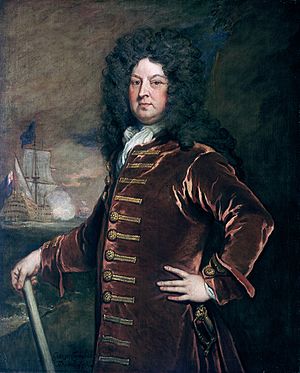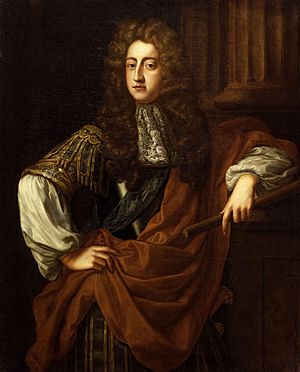George Churchill (Royal Navy officer) facts for kids
Quick facts for kids
Admiral George Churchill
|
|
|---|---|

Admiral George Churchill, by Godfrey Kneller
|
|
| Born | 20 February 1654 Minterne Magna, Dorset |
| Died | 8 May 1710 (aged 56) Home Park, Windsor |
| Buried | |
| Allegiance | |
| Service/ |
|
| Years of service | 1666–93, 1699–1708 |
| Rank | Admiral of the Blue |
| Unit | Lieutenant-Colonel Horse Guards 1691 |
| Commands held | Lord Commissioner of the Admiralty 1699–1708 |
| Battles/wars | Second Anglo-Dutch War Third Anglo-Dutch War Nine Years War Bantry Bay Beachy Head Barfleur & La Hogue War of the Spanish Succession |
| Relations | John Churchill, 1st Duke of Marlborough (brother) General Charles Churchill (brother) James FitzJames, 1st Duke of Berwick (nephew) |
| Other work | Member of Parliament (MP) St Albans 1685–1708 Portsmouth 1708–1710 † |
George Churchill (born February 20, 1654 – died May 8, 1710) was an important English naval officer. He reached the rank of Admiral of the Blue. He also served in the government as a Lord Commissioner of the Admiralty. This role meant he helped manage the navy.
George Churchill was also a Member of Parliament (MP). He represented St Albans from 1685 to 1708. Later, he represented Portsmouth from 1708 until his death. He was a close friend of Prince George of Denmark, who was married to Queen Anne. This friendship helped him achieve high positions.
He passed away in May 1710 and was buried in Westminster Abbey. He never married but had a son, George Churchill (1687–1753).
Contents
Early Life and Family Connections
George Churchill was born on February 20, 1654, in Minterne Magna, Dorset. His father was Sir Winston Churchill. His mother was Elizabeth Drake. His father fought for the Royalist Army during the Wars of the Three Kingdoms. This led to financial difficulties for the family.
George had two famous older brothers. They were John, who became the Duke of Marlborough, and Charles. John and Charles were usually political Whigs. George, however, was a Tory. This difference in political views sometimes caused disagreements between them.
He was very close to his sister, Arabella. Arabella was a companion to James II before he became king. Her relationship with James helped her brothers get important jobs early in their careers. Arabella was buried next to George in Westminster Abbey.
George Churchill never married. However, he had a son named George Churchill with a woman named Mary Cooke. His son inherited most of his property. This son later became a general in the British Army.

George Churchill began his naval career in 1666. He was commissioned as a Lieutenant in the Royal Navy. He did not serve on a ship right away. Instead, he worked as a page for the Earl of Sandwich in Spain.
After returning, he briefly worked as a draper's apprentice. He then returned to military service in 1672. This was during the Third Anglo-Dutch War. From then on, he held various roles in both the army and navy.
George's brother, Charles Churchill, was friends with Prince George of Denmark. In 1683, Prince George married James II's daughter, Anne. George Churchill became very close to Prince George. This friendship was key to his success later in life.

In 1685, George Churchill was elected as a Member of Parliament (MP) for St Albans. This was a seat controlled by his elder brother, John.
Before the Glorious Revolution in November 1688, George took command of HMS Newcastle. He claimed his ship was leaking and entered Plymouth. Plymouth soon declared support for William III. This was an early and important naval defection.
He fought in several major naval battles. These included Bantry Bay in May 1689 and Beachy Head in July 1690. Beachy Head was a defeat that caused concern in England. Churchill was a friend of the commander, the Earl of Torrington.
In 1691, Churchill became a Lieutenant-Colonel in the Horse Guards. He commanded the large 96-gun ship HMS St. Andrew at the Battles of Barfleur and La Hogue in June 1692.
Later Career and Retirement

In 1693, George Churchill resigned from active naval service. This was due to disagreements within the navy. However, he kept his seat as an MP. He also maintained his strong connection with Prince George. When a new leader was needed for the navy in 1699, George was appointed a Lord Commissioner of the Admiralty.
When Anne became Queen in 1702, her husband, Prince George, became Lord High Admiral. George Churchill became a member of the council that advised him. For the next six years, they largely managed naval operations during the War of the Spanish Succession.
By 1707, there was criticism about how naval affairs were handled. Some political groups wanted Churchill to resign. However, he kept his position with support from the Queen and Prince George. In the 1708 election, he switched from representing St Albans to Portsmouth.
When Prince George died in October 1708, George Churchill retired. He moved to a house in Windsor. He was known for having a large and famous aviary (a place for birds). When he died in May 1710, he left his aviary to his friends. His remaining money was split between his son and nephew.
Images for kids







